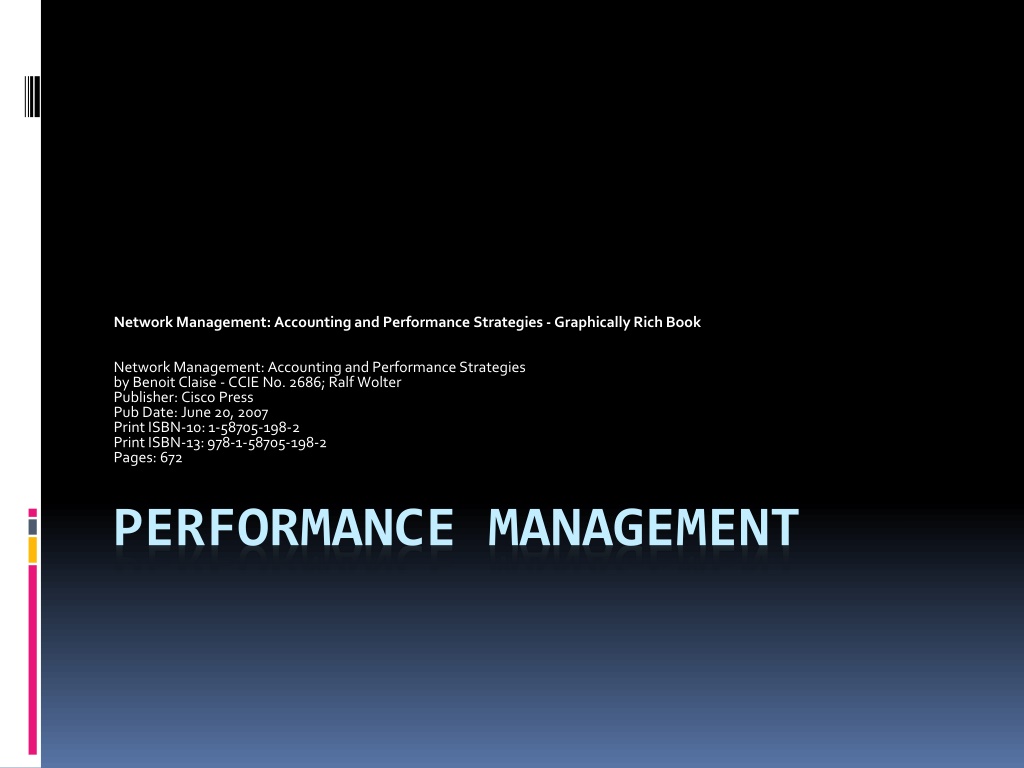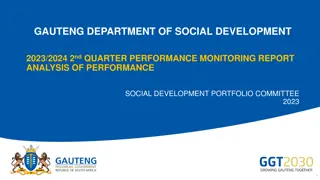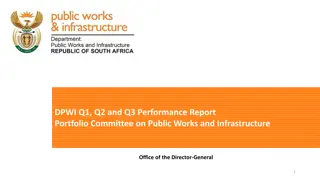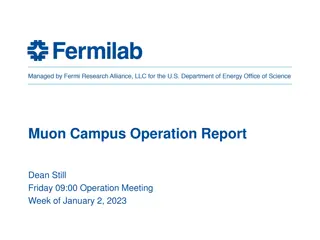
Network Management Strategies for Performance and Accounting
Explore the significance of performance management in network systems, including its functions, definitions, and role in monitoring and optimizing network performance. Learn about ITU-T and TMF definitions, SLA management, and proactive maintenance practices.
Download Presentation

Please find below an Image/Link to download the presentation.
The content on the website is provided AS IS for your information and personal use only. It may not be sold, licensed, or shared on other websites without obtaining consent from the author. Download presentation by click this link. If you encounter any issues during the download, it is possible that the publisher has removed the file from their server.
E N D
Presentation Transcript
Network Management: Accounting and Performance Strategies - Graphically Rich Book Network Management: Accounting and Performance Strategies by Benoit Claise - CCIE No. 2686; Ralf Wolter Publisher: Cisco Press Pub Date: June 20, 2007 Print ISBN-10: 1-58705-198-2 Print ISBN-13: 978-1-58705-198-2 Pages: 672 PERFORMANCE MANAGEMENT
Understanding the need for Performance Management What is performance management? Why do networks require performance management? Which problems does performance management solutions solve? What aspects make up performance monitoring (data collection, data analysis, reporting, billing, and so on)?
Defining performance management
ITU-T definition (M.3400 and X.700, Definitions of the OSI Network Management Responsibilities): Performance Management provides functions to evaluate and report upon the behavior of telecommunication equipment and the effectiveness of the network or network element. Its role is to gather and analyze statistical data for the purpose of monitoring and correcting the behavior and effectiveness of the network, network elements, or other equipment and to aid in planning, provisioning, maintenance and the measurement of quality.
ITU-T definition (M.3400 and X.700, Definitions of the OSI Network Management Responsibilities): Performance management includes functions to: management includes gather statistical information Performance functions to: maintain and examine logs of system state histories system performance under natural and artificial conditions determine system modes of operation for conducting performance management activities alter
This process manages the SLAs and reports service performance to the customer. TMF definition: The TMF defines performance and SLA management in the context of assurance. The assurance process is responsible for the execution of proactive and reactive maintenance activities to ensure that services provided to customers are continuously available and to SLA or quality of service (QoS) performance levels. It performs continuous resource status and performance monitoring to detect possible failures proactively, and it collects performance data and analyzes it to identify potential problems to resolve them without affecting the customer.
TMF definition: Related documents are TMF 701, Performance Reporting Concepts & Definitions; TMF GB917, SLA Management Handbook, which also refers to ITU M.3010; and the FAB model of the eTOM.
Purposes of Performance Various performance scenarios: Network Performance Device Performance Service Monitoring Monitoring Monitoring Baselining
Device Performance Monitoring Network Element Performance Monitoring From a device perspective, we are mainly interested in device "health" data, such as overall throughput, per-(sub)interface utilization, response time, CPU load, memory consumption, errors, and so forth System and Server Performance Monitoring Low-level service monitoring components: - System: hardware and operating system (OS) - Network card(s) - CPU: overall and per system process - Hard drive disks, disk clusters - Fan(s) - Power supply - Temperature - OS processes: check if running; restart if necessary - System uptime High-level service monitoring components: - Application processes: check if running; restart if necessary - Server response time per application - Optional: Quality of service per application: monitor resources (memory, CPU, network bandwidth) per CoS definition - Uptime per application
Figure 1-23. Catalyst 6500 NAM ART Measurement A practical approach is to measure the server performance with the Cisco IP SLA or Cisco NAM card for the Catalyst switch. The NAM leverages the ART MIB and provides a useful set of performance statistics if located in the switch that connects to the server farm
Network Performance Monitoring: Transmission efficiencyTransmission efficiency Jitter (delay variation)Jitter (delay variation) Network delay Network response time throughput/capacity Utilization (device, Network delay Packet loss network) Network
Service Monitoring From a service perspective, here are significant parameters to monitor: Jitter (delay variation)Jitter (delay variation) Mean Opinion Score (MOS) in the case of voice Key Quality Indicators (KQI) Service availability Service delay Mean Opinion Score (MOS) in the case of Key Performance Packet loss Indicators (KQI) Indicators (KPI) Key Quality voice
Service meaning A generic definition by Merriam-Webster declares: "A facility supplying some public demand...." More specifically, related to IT, we define a service as a function providing network connectivity or network functionality, such as the Network File System, Network Information Service (NIS), Domain Name Server (DNS), DHCP, FTP, news, finger, NTP, and so on. Service The definition of a certain level of quality (related to specific metrics) in the network with the objective of making the network more predictable and reliable. Service level A contract between the service provider and the customer that describes the guaranteed performance level of the network or service. Another way of expressing it is "An SLA is the formalization of the quality of the service in a contract between the Customer and the Service Provider. Service level agreement (SLA) The continuously running cycle of measuring traffic metrics, comparing those metrics to stated goals (such as for performance), and ensuring that the service level meets or exceeds the agreed-upon service levels Service level management
Table 1-8 provides some generic SLA examples. Table 1-8. Generic SLAs SLAs Class Premium Application Broadcast videoTraditional voice Availability: 99.98/99.998 percent Latency: 50 ms maximum Packet delivery: 100 percent Jitter: 2 ms maximum Optimized Availability: 99.98/99.998 percent Compressed video Latency: 50 ms maximum Packet delivery: 100 percent Jitter: 10 ms maximum Voice over IP Mixed application Virtual private network Best effort Availability: 99.98 percent Internet data Latency: 50 ms maximum Packet delivery: 99.95 percent
Baselining Baselining is the process of studying the network, collecting relevant information, storing it, and making the results available for later analysis. A general baseline includes all areas of the network, such as a connectivity diagram, inventory details, device configurations, software versions, device utilization, link bandwidth, and so on.
Baselining tasks include the following: device inventory information (physical as well as logical). This can be collected via SNMP or directly from the command-line interface (CLI) for example, show version, show module, show run, show config all, and others. Gather statistics (device-, network-, and service-related) at regular intervals. Gather Document the physical and logical network, and create network maps. the protocols on your network, including Identify
Baselining tasks include the following: the protocols on your network, including Identify - Ethernet, Token Ring, ATM - Routing (RIP, OSPF, EIGRP, BGP, and so on) - Legacy voice encapsulated in IP (VoIP) - IP telephony - QoS (RSVP) - Multicast - MPLS/VPN - Frame Relay - DLSW
Baselining tasks include the following: Identify the applications on your network, including - Web servers - Mainframe-based applications (IBM SNA) - Peer-to-peer applications (Kazaa, Morpheus, Grokster, Gnutella, Skype and so on) - Backup programs - Instant messaging statistics over time, traffic flows. Monitor & study
From a performance baselining perspective, we are primarily interested in performance-related subtasks network device-specific details: Collect - CPU utilization - Memory details (free system memory, amount of flash memory, RAM, etc.) - Link utilization (ingress and egress traffic) - Traffic per class of service - Dropped packets - Erroneous packets
From a performance baselining perspective, we are primarily interested in performance-related subtasks Gather server- and (optionally) client-related details: - CPU utilization - Memory (main memory, virtual memory) - Disk space - Operation system process status - Service and application process status Gather Service related information : - Round-trip time - Packet loss (delay variation jitter) - MOS (if applicable)
both performance monitoring and accounting management gather usage data used as input for various management applications. Performance management is one example of a management area that benefits from performance monitoring and accounting, but also actively modifies the network and its behavior. Without accounting, you can hardly identify the cause of bottlenecks and outages identified by performance management. without performance monitoring you operate the network blindfolded.
Figure 1-6. Complementary Solution The intersection between the two areas is typically the network monitoring part. This is a generic term for any data collection tasks that are common between accounting management and performance management.






















